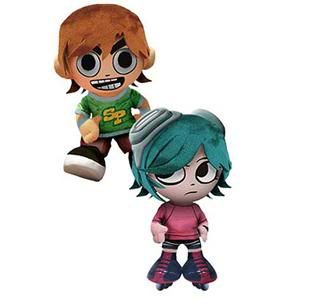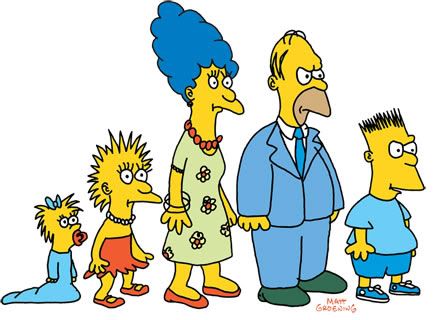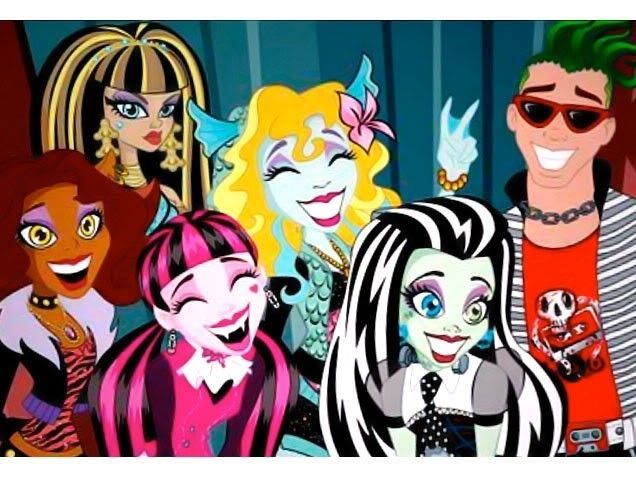Yet the biggest shock when venturing further into the Macross universe was the apparent retconning of Exsedol Folmo into a completely new personality and design, which in the process removed many of the qualities that had captured my interest and seemed to terminate his character arc, transforming him into little more than a device.
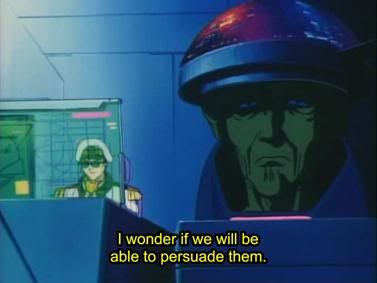
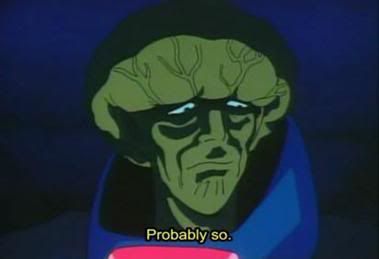
Neo-Exsedol appears as a minor character in the sequel to the original TV series,
Macross 7; physically, he is essentially his DYRL design, though with some minor colour differences. At full Zentradi size, he sits (?) underneath the bridge of a ship, his giant (in more ways than one) head sticking up Whac-A-Mole style through the floor to be beside the captain’s chair, a captain who just happens to be Max Jenius from the original series. Later episodes show Exsedol leaving the ship and moving around, but he remains in that certain position until more than halfway through the series, and even then usually does not go anywhere much.
This depiction confused some anime fans in 1994, with them demanding to know how he had gotten that way. These days, most Macross fans seem to accept Neo-Exsedol as a matter of course, with the confusion being instead over why he is still an issue. However, Neo-Exsedol is a major snag for me, a major reason why I can't view Macross as a "complete", ordinary media franchise, but always look at it with some twitchiness.
I’ve already made my preference for Classic Exsedol’s physical appearance clear, and that’s certainly one of my issues with Neo-Exsedol. But Neo-Exsedol also has a new, less appealing personality, with a reduced emotional range, limited mobility, and just a different texture. On top of that, there’s no explanation as to
why he is virtually a new character.
In addition to barely moving, his bearing is flat and deadpan, and he sports a nearly perpetual frown. Sometimes this is broken by sudden comical fits of terror, but overall Exsedol remains at this one level setting. When the fleet is in crisis, he also has a tendency to fall into bleak pessimism. Though still voiced by Japanese actor Ryunosuke Obayashi, in
Macross 7 Exsedol even has a different voice: deeper, slower, more resonant, and, contradictorily, younger-sounding.
Neo-Exsedol also often seems more like a device than a full-fledged cast member. He is too big and too stationary to have much of in the way of meaningful interaction with the other characters. Even when he is showing some kind of friendliness towards them, there is a sense of distance because he is merely a Big Talking Thing in the Background.
The promotional art for
Macross 7 also suggests this remoteness, because Exsedol is usually absent from these images, even in shots that are otherwise crammed with rest of the cast. Though his size would prevent appearance in some of the more standard group shots, some acknowledgement of his existence would be welcome.
(An “extra” episode of
Macross 7,
"Fleet of the Strongest Women does show a slightly more involved Exsedol. He isn’t that large a departure from the way he is in the rest of the series, but slightly more appealing nonetheless.)
Now, none of his traits would be objectionable on a completely original character, but they are a tremendous departure from the reasons I was drawn to Classic Exsedol. Neo-Exsedol may have that same basic role of “geek on the bridge”, but that is only a small part of what endeared the character to me. The design and personality of Neo-Exsedol are much less fascinating than the original, and all we see is that he is static.
His physical inertness is partially out of necessity, because of he is a giant character in a place built for humans, but there’s no explanation as to why he remains in that state, and his emotional inertness remains. I’m also put off by his blanket pessimism, since crises in the fleet always prompt him to lament that none of them are going to succeed, in contrast to his quick response to the looming threat in SDFM.
Nevertheless, one of my major interests in Exsedol was his potential character development. In Super Dimensional Fortress Macross, there were brief hints dropped about Exsedol’s interest in Earth culture, and these fuelled my interest in his character growth. On hearing the spy trio’s first testimony of human life, Exsedol expresses an interest in going to Earth. He finds the drinks served at the peace talks to be surprisingly delicious, and seems to adjust well to being at human size for the remainder of the series.
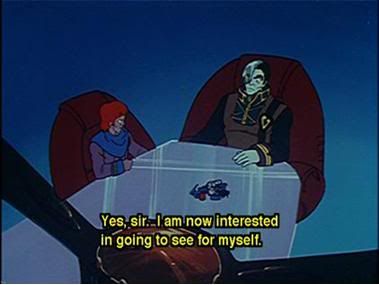
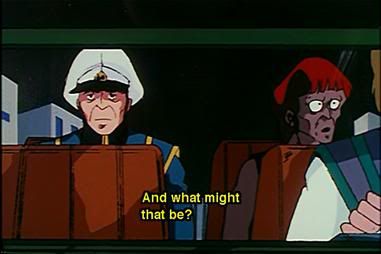
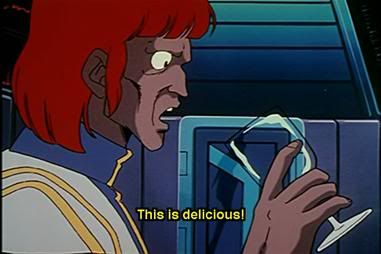
At that time, I could picture Classic Exsedol becoming part of the human world to a degree on par with Milia and the spies, an image that was essential to giving him that complete arc. As I’ve admitted, the writers did not need to show this completeness, but it was a potential possibility.
With Neo-Exsedol, however, I have no room to play, since he is the absolute antithesis of his original portrayal. Though
Macross 7 took place thirty-three years after the original series, my instinctive response was that Neo-Exsedol does not seem to follow logically from the TV series even if I looked at his characterization and not his body…unless you wanted to be really dark and think that the events of “Satan’s Dolls” drove Exsedol into that static, distant position, and I’m not willing to go that far.
Now, I’ve relented
slightly on this position, at least when I’m in the mood to. One could say that Neo-Exsedol’s characterization is the product of a more realistic aging process than consumers of popular entertainment are used to. While most series try to keep aged characters familiar, in real life people can change radically over their lifetimes. So Exsedol, though he showed some interest in human culture in 2012, might have by 2045 been more comfortable just sitting somewhere, especially since he refers to himself as an “old man”. Theoretically, this leaves thirty-three years of a “blank” period in which I could have my own fun.
However, I can’t do this, for several reasons That Exsedol is a fictional character makes all the difference; I cannot shed that expectation of consistent depiction across a character’s lifespan, making it hard to try to make the most of what I’ve been given in replacement. A fan grows attached to what a character is as they first see them, and is less willing to
follow along with radical change than they would be with a real person.
Neo-Exsedol is too
different,
and whatever happens to him, he would arrive at that position where he
had been drained of almost everything interesting. Besides, Macross, as a
universe, did not set up any expectation of realistic treatment of
anything else, so was might have been a realistic attempt at aging
characters comes off as jarring.
An additional problem is that the past events of the new Macross canon can never be truly known, and hence neither can Classic Exsedol’s existence. Later Macross anime make references both to the TV series events and to the events of
Do You Remember Love? by turns, with DYRL being an in-universe movie on top of that. There has never been any outline published of what exactly is canon and what is not.
This created a specific dilemma for me. While with most other characters, they could have their same events with their retconned designs, with Exsedol it left some huge questions open. Have the appearance and traits of Classic Exsedol been lost with time or had they never even been present? Did he have the personality of Classic Exsedol, or of Neo-Exsedol? Any of these prospects would radically change the way Exsedol worked in SDFM. You cannot simply replace Classic Exsedol’s scenes with Neo- Exsedol and have them come off the same, and therefore more specific details are required.
Furthermore, because Macross and Exsedol are someone else’s creations, my own imaginings can never substitute for an official word from on high. I don’t expect one anymore, but it is the ideal circumstance; being left to figure out things on my own is disorienting, not because I’m stupid, but because I usually try to respect the boundaries and authority of creators. I might be able to make up theories about Neo-Exsedol, but will never actually know if that was the intent. I may complain about Neo-Exsedol, but I could never just dismiss his existence because I didn’t like it; he’s canon, and I must engage with his portrayal rather than pretending he never happened.
Neo-Exsedol’s body is even harder to explain away. I did not like the way he looked in comparison to the original form, but things were worse because I then had to contend with several red herrings regarding his current state. Early on, I was willing to assume that there was some in-story explanation involved, that Classic Exsedol had somehow
become Neo-Exsedol. It looks absurd to be now, but I was operating on expectations formed by the majority of popular entertainment, where radical changes were explained in-story. I still prefer their methods over Macross’ ambiguity.\
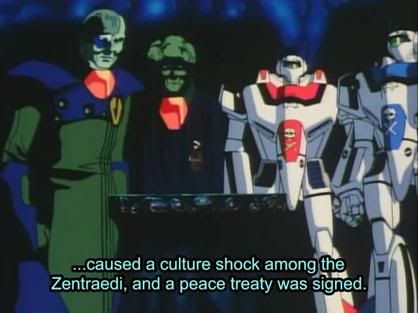
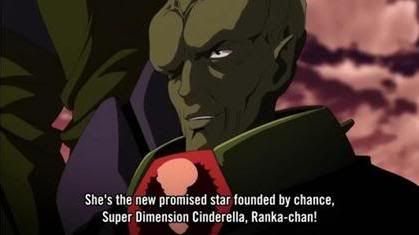
One possible explanation for Neo-Exsedol involved a quote from the
Macross 7 DVD liner notes: “Although he [Exsedol] was Micloned at one time, he purportedly returned to his former Zentradi size and realtered his body makeup for fear of losing his cerebral capacity and memories.” While my automatic response (and those of
other fans years before), was to interpret this as meaning that Exsedol had been modified in-story from the TV series design, maybe due to some dreadful illness, I slowly realized that this didn’t work as an explanation for several reasons.
First, nothing else was ever said to supplement or clarify this lonely liner note, either published or inside the stories. Exsedol also appears with the DYRL design in flashbacks in
Macross 7, and is part of a larger display of DYRL aesthetic in later Macross anime. Because of these last two things, it is impossible to believe that there was anything “special” about Neo-Exsedol’s physical appearance. And in the next TV series,
Macross Frontier, an apparent clone of Neo-Exsedol’s Zentradi type was seen, finally killing the modification theory that was already gasping for breath.
In the face of all this, I decided to assume that Classic Exsedol never existed in the current Macross continuity, and that Neo-Exsedol in
Macross 7 is consistent with whatever came before him, having never acted or looked like Classic Exsedol in the past. Of course, this didn’t go down easy: on top of essentially erasing that character and necessitating new and likely less-compelling versions of his primary scenes, it was still an informal, unofficial explanation.
Sometimes I wish instead that
Do You Remember Love? was established as the official background for all new Macross anime, since it would have neatly solved the Exsedol Question. The result would not have been pleasing but it would have been clear, for the
Macross 7 version of Neo-Exsedol works much better as a continuation of his DYRL self than of Classic Exsedol, and not only on physical terms. DYRL Neo-Exsedol has nothing that creates the expectation that he’ll do anything else beyond transferring his current role to the human army, and the
Macross 7 version seems like a much more pleasant individual in comparison to him, making for adequate character development when the character wasn’t all that fleshed out to start with.
Another, more recent theory, was that Neo-Exsedol somehow takes the shape of Classic Exsedol when micloned, which would allow his scenes from the original series to remain intact at least in terms of physical action. From here, we could go back to the infamous liner note and assume that Exsedol chooses the impractical condition of remaining at his natural size because he has some physiological difficulties with being micloned. The theory of a more realistic aging process would then be employed to explain his new personality. His “new” voice may even be what he sounds like when at his natural size, and so on and so forth.
But it is still not good enough. This is just the imagination of fans, which is not the same as something official. I resigned myself to never being able to get anything more, just before finding out that Shoji Kawamori, one of the men involved with Macross,
went on record as saying that since all Macross works were fictional, they could be treated as altering takes on a non-existent “real” event, similar to how all WW II movies were different from the real war. Hence, perhaps, Neo-Exsedol and Classic Exsedol were to be perceived as two different actors playing the same role in different versions of a war drama. Or, more simply put, there was no need to worry about stability when it was all fictitious anyway. There was no “real” Zentradi war, so why stress consistency?
Yet it is not too much to expect stability and clarity from fiction, instead of going off and doing anything because it’s “just fiction”. Even if very few viewers were as invested in the portrayal of Exsedol as I was, they were still left confused and for no good reason, so I failed to have much sympathy for Kawamori. This “official” response also had me thinking that Neo-Exsedol was a writer’s whim and not “meant” to be thought about in the same manner that fans did.
Writers can have their whims, of course, but it all bothers me anyway. Exsedol was my favourite character in the series, and virtually replacing one character with a new one is an unpleasant thing, no matter how minor he is. Some clarification on how much of his original SDFM appearance and portrayal were still canon to the mainstream Macross would have eased my difficulties, but I realize that that is not going to happen. Ultimately, Neo-Exsedol cannot be explained in terms of anything but fan theories: he simply
is.
This extreme case of retroactive continuity and its related lack of “growth” is especially conspicuous when weighed against the portrayal of Mila Fallyna Jenius in
Macross 7. I did find Milia a problematic character in that series because she often comes off as a petty, petulant harpy who is comic relief because she is an older woman who is sexual and outspoken. But it is also clear that Milia has lead a rich, full life, taking a variety of jobs and moving about freely in the human world.
She also looks almost the same as she
originally did, apparently ageless, with only cosmetic differences in
dress, hairstyle, and modernized art design. While Exsedol and Milia
were obviously different in how prominent they are in the story, it still stings a
bit. It is not that Milia’s life is more directly explored (that is to
be expected), but that she
has one, while Exsedol is written in a
way that cuts off the possibility of being anything more than a big
talking head, when both embodied the changes in the Zentradi.
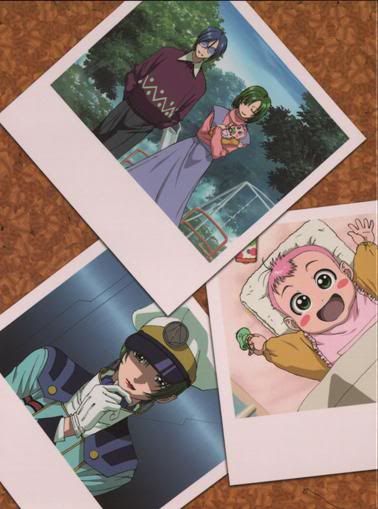
Besides being so different from what I enjoyed, Neo-Exsedol also seems to be a largely useless character in
Macross 7, to the point where I find it hard to imagine why he is part of the cast of at all. Allegedly, his purpose is to inform the characters about the enemies in the series, called the Protodevlin: energy vampires in the bodies of humans and genetic constructs, who are ancient enemies of the Zentradi. Exsedol, being a veteran Zentradi, lends the enemies’ existence some gravitas, for he can tell you just how badass they are, though largely through his own terror.
Exsedol’s vast knowledge appears to be largely useless. He has a few scenes of translation and analysis, but they seem like things that other educated scientists and personnel could have done by themselves (though perhaps accessing databanks filled with knowledge he gave them), and Exsedol and the other scientists are usually one step behind the truth, too.
Exsedol is also terrified of the Protodevlin, an apparently reflexive fear that drives him to retreat into his floor opening for several episodes, crying “Protodevlin!” The image of Exsedol sinking away, only his shivering braincase visible, doesn’t feel right either. The character has never been macho, but the Protodevlin turn out to be such ridiculous villains in their goofy appearance, cheesy personalities, and method of defeat (being repelled and then pacified through rock music) that his paroxysms seem unjustified.
 Click to enlarge image
Click to enlarge image
The way that Exsedol expresses fear makes him look even more comedic, without the integrity and the vivacity that Classic Exsedol had to balance out
his humorous moments. Furthermore, because there are other reasons to fear the Protodevlin besides Exsedol’s own terror, his looking ridiculous is unnecessary to drum up fear of those enemies, either.
Otherwise, Neo-Exsedol’s role in
Macross 7 consists largely of needless exposition or pointless dialogue. It would be easy to “stitch up” the scenes where he is supposedly needed and then to cut him from the series. There would still be enough offhand references outside of Macross 7 to suggest that Neo-Exsedol had been retconned, but it would be better if he was not put through the rigmarole of Macross 7. Why make him a cast member, and re-create him as a new character, if you are going to do nothing with him?
Yet I suppose I ought to be clean about it and say that, despite all this, I do have a certain love for the
Macross 7 version of Neo-Exsedol. I find him to be rather likeable, and take more of an interest in him than anything else in the series. He’s also a nice contrast to just about every other giant-brained character in fiction, looking like a B-movie monster but actually a nice guy, if rather deadpan. It is only the knowledge that he is “replacing” a much better character, with little interest in explaining how or why, that agitates me. At best, Neo-Exsedol is a guilty pleasure, and at worst, he is the main reason why I cannot become a pure Macross fan. What is a minor quibble for most viewers is a deal-breaker for me. Not only was his design changed, but his entire personality and manner, too.
This handling of Exsedol, Warera, Rori, Konda, and Britai was a real kick in the ovaries, especially when it was reasonable to expect that the Macross universe would be nothing but superior to Robotech when it came to handling the characters who originally came from it. Unlike many other fans, I do not feel the urge to “protect” my favourite Macross characters from representation in Robotech, because Macross has already done a fair job of screwing up these characters on its own.
I’m aware that these five are secondary characters, but it doesn’t follow that I should expect them to change at the drop of a hat, and never grow attached to any aspect of them since it may all disappear.
The question about my favourite Zentradi that always lingers in my head is, “What about afterward?” It is essential to be able to picture those characters experiencing the fruits of human culture, finding broader experiences, greater emotions, and new successes. Unfortunately, this is not what happened.
When such things are only restricted to Milia, I get the nagging feeling that the human-friendly male Zentradi from the original TV series end up forgotten by the Macross universe: written poorly, drastically altered, and never allowed to develop fully. Set against this, the happy fate of the majority of Zentradi becomes a little more of a distant interest, though I have some problems with that portrayal as well.
